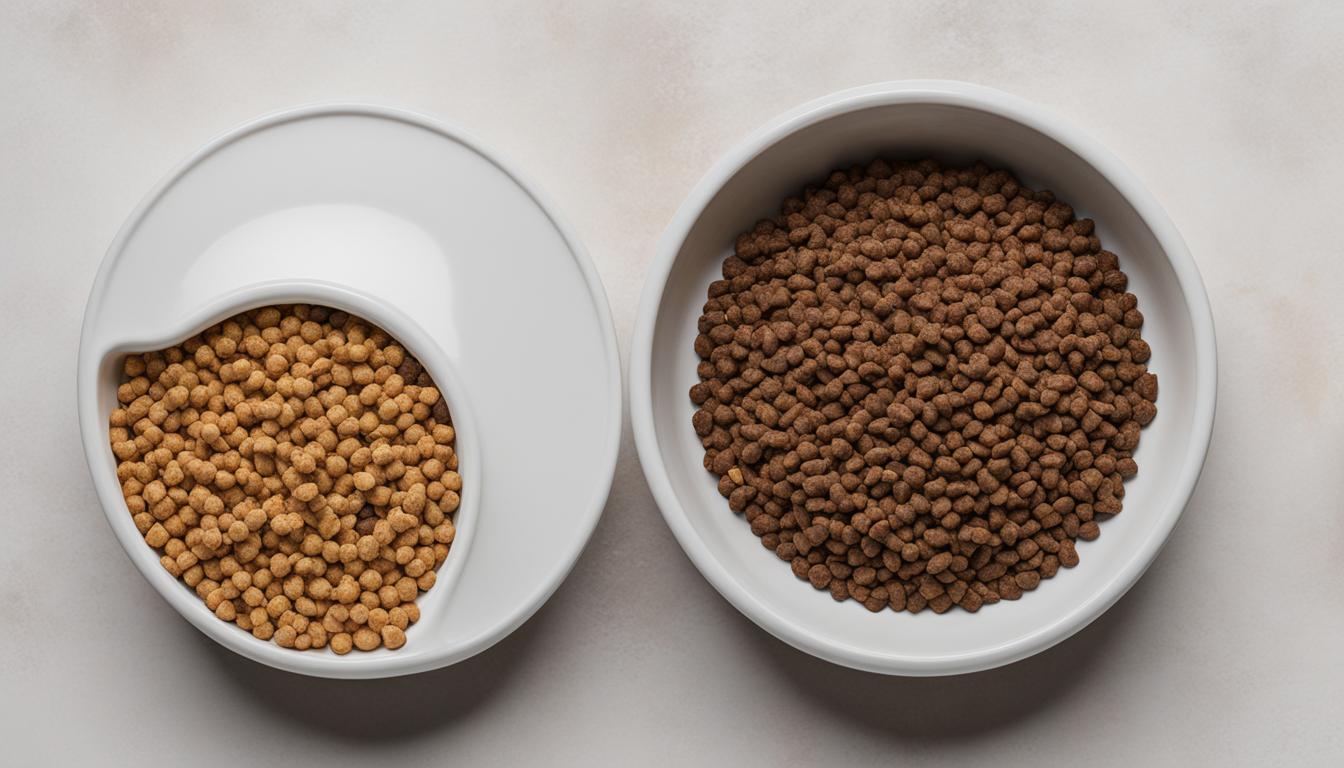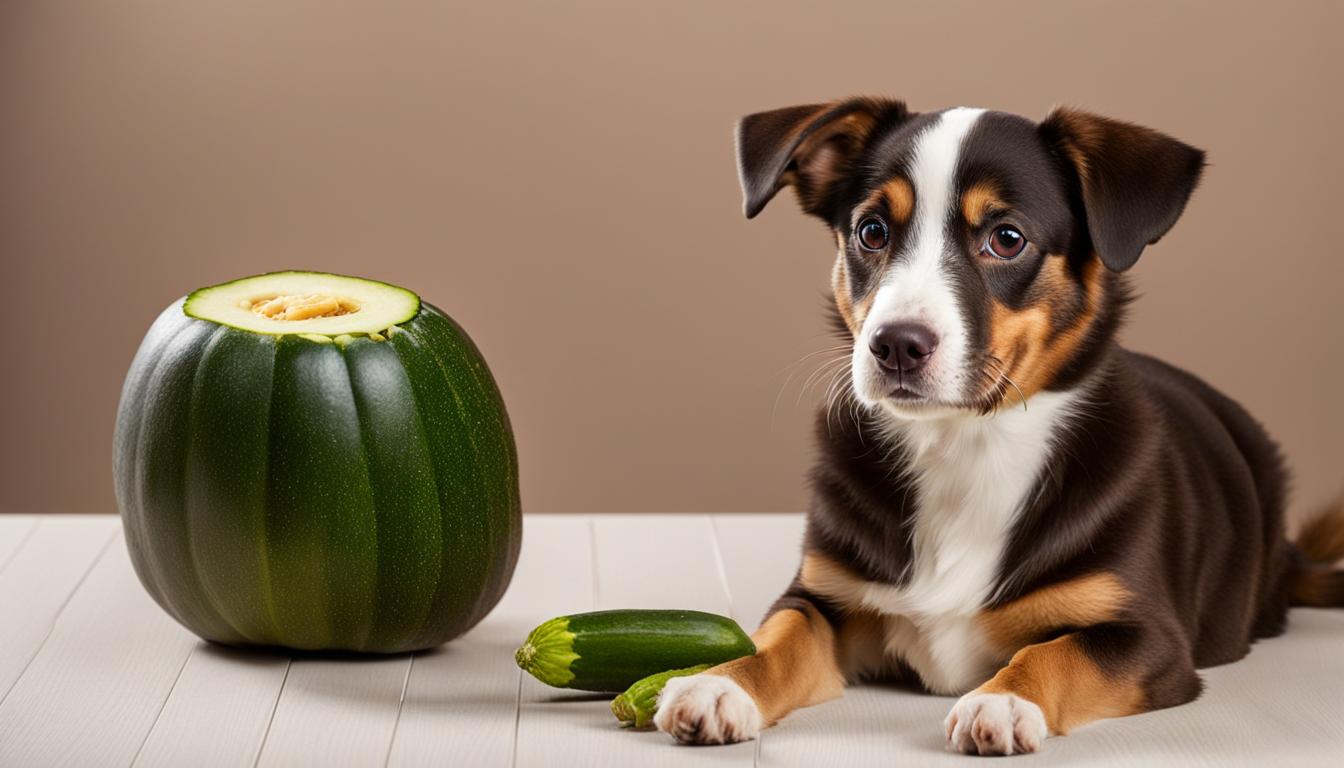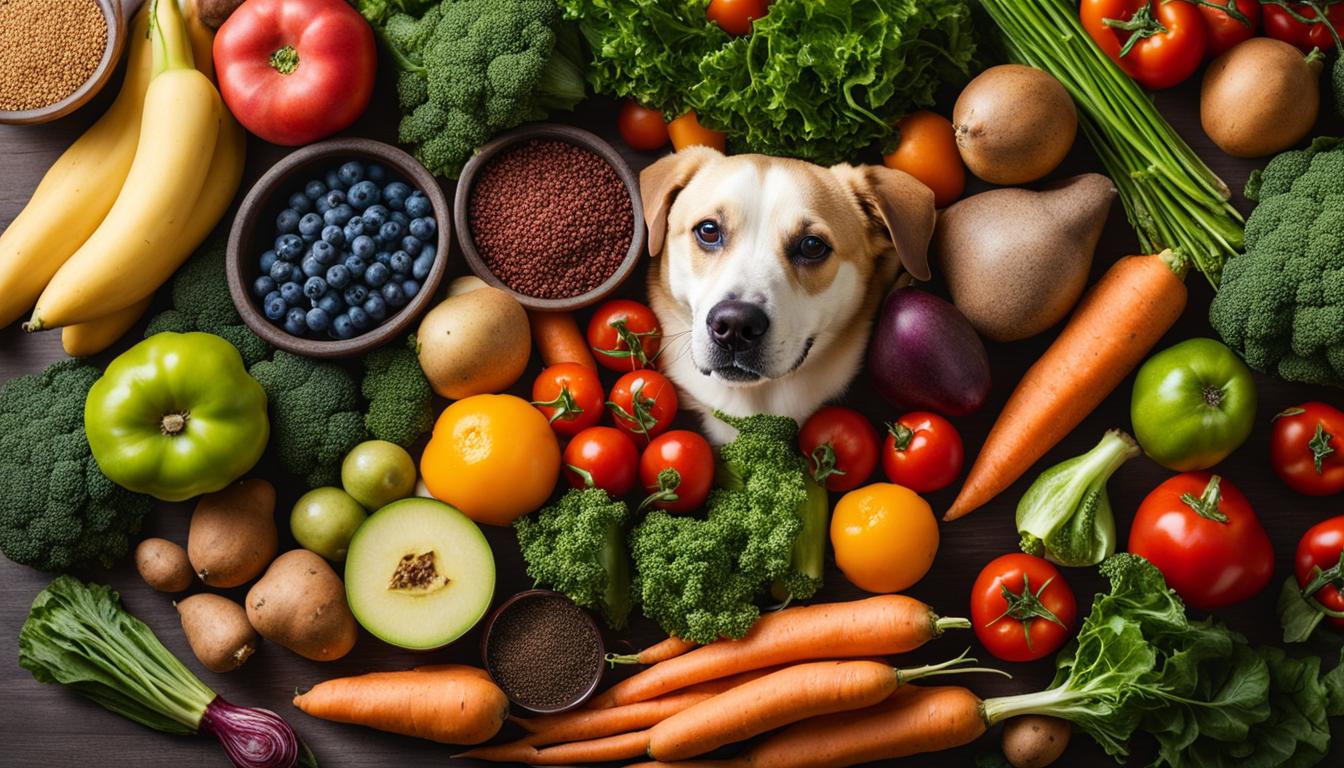Choosing the right dog food can be a daunting task, especially with so many options available. Two popular choices are wet and dry dog foods. But which one is best for your furry friend? Let’s dive in and explore the differences between these two options to help you make an informed decision.
Key Takeaways:
- Wet dog food has a higher moisture content, making it beneficial for dogs with hydration issues.
- Dry dog food promotes dental health and is more convenient for pet owners.
- Consider your dog’s specific needs and preferences when choosing between wet and dry dog food.
- Consult with a veterinarian to determine the best option for your dog’s nutritional needs.
What’s the Difference Between Wet and Dry Dog Food?
When it comes to dog food, wet and dry options are popular choices. But what exactly sets them apart? Let’s take a closer look at the processing methods of wet and dry dog food to understand their differences.
Wet dog food is made by grinding protein sources and blending them with a gravy that includes essential vitamins, minerals, and grains. This mixture is then cooked and sterilized to create the canned product. On the other hand, dry dog food is produced by pulverizing the meat mixture into a dough-like consistency. The dough is then extruded through shaped holes to form kibble. The kibble undergoes a drying process and is sprayed with fats, oils, and a blend of vitamins and minerals before being packaged.
So, while wet dog food is cooked and sterilized in its canned form, dry dog food is produced by extruding and drying a dough-like mixture. These different processing methods result in distinct textures and characteristics for each type of food, which can influence your dog’s preference and overall feeding experience.
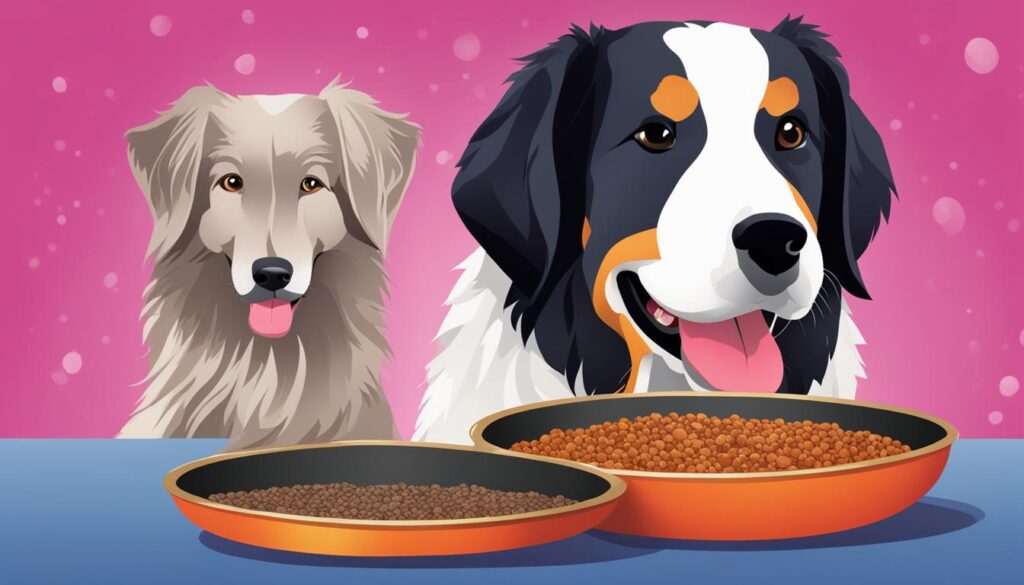
Comparing Wet and Dry Dog Food Processing
Here’s a quick overview of the processing techniques for wet and dry dog food:
| Wet Dog Food | Dry Dog Food |
|---|---|
| Grinding of protein sources | Pulverizing of meat mixture |
| Mixing with gravy, vitamins, minerals, and grains | Extrusion of dough-like mixture |
| Cooking and sterilization | Drying and spraying with fats, oils, and nutrients |
Understanding the differences in processing methods can help you make an informed decision about which type of dog food is best for your furry friend.
Benefits of Wet Dog Food Compared to Dry Dog Food
When it comes to choosing the right dog food for your furry friend, you may find yourself torn between wet and dry options. Wet dog food, also known as canned food, offers several benefits that make it a popular choice among pet owners.
One of the key advantages of wet dog food is its higher moisture content. With an average moisture content of around 75%, wet food provides essential hydration for dogs that may not drink enough water on their own. This is particularly beneficial for dogs with hydration issues or medical conditions that require proper hydration.
Another benefit of wet dog food is its palatability. The moist and flavorful texture of canned food often appeals to even the pickiest eaters. This can be especially helpful if you have a dog that is reluctant to eat or has a decreased appetite.
Wet dog food also tends to create a feeling of satiety, or fullness, which can be beneficial for weight management. The higher moisture content and increased volume of wet food can help your dog feel more satisfied, reducing the urge to overeat.
| Benefits of Wet Dog Food | Benefits of Dry Dog Food |
|---|---|
| Higher moisture content | Promotes dental health |
| Palatability and flavor | Convenience |
| Satiety and weight management | Cost-effective |
| Easier to chew | Food enrichment |
Additionally, wet dog food is easier to chew, making it suitable for dogs with dental disease or oral abnormalities. The soft texture of canned food can be gentler on their teeth and gums, providing them with a more enjoyable eating experience.
While wet dog food offers these unique benefits, it’s important to consider your dog’s individual needs and preferences when making your decision. Some dogs may thrive on a wet food diet, while others may do better with dry food. Consulting with your veterinarian can help you determine the best option for your four-legged companion.
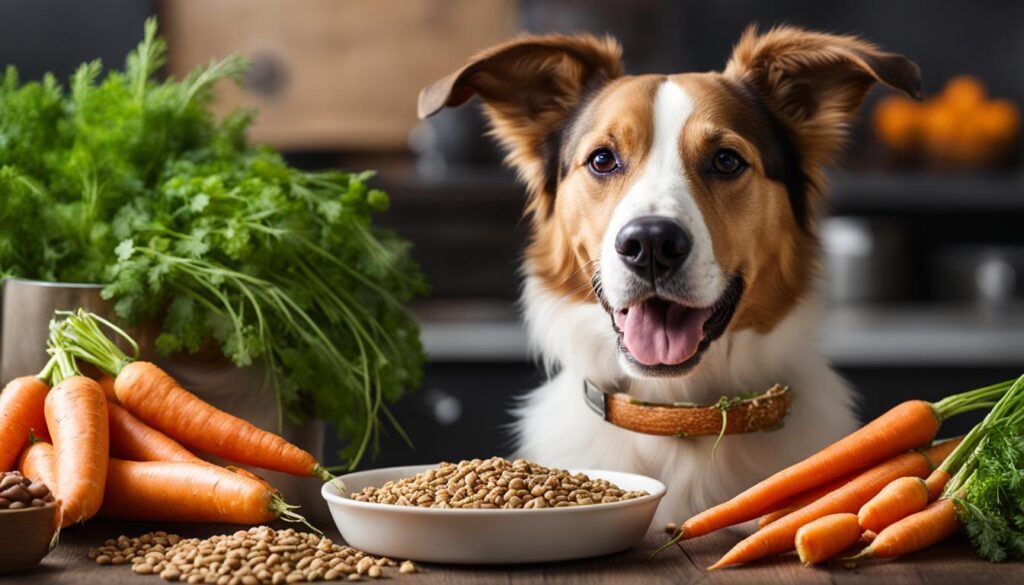
| Benefits | Dry Dog Food | Wet Dog Food |
|---|---|---|
| Promotes Dental Health | ✓ | ✕ |
| Convenience | ✓ | ✕ |
| Financial Feasibility | ✓ | ✕ |
| Food Enrichment | ✓ | ✕ |
What Wet Dog Food Do Veterinarians Recommend?
When it comes to wet dog food, veterinarians often recommend several trusted brands that prioritize the nutritional needs of your pet. These brands include Royal Canin, Science Diet, and Purina Pro Plan. Each brand offers a wide range of options designed to cater to different life stages and specific dietary requirements.
Royal Canin is a popular choice among veterinarians due to its commitment to scientific research and tailored nutrition. They provide wet dog food formulas that address specific health concerns such as digestive sensitivities, weight management, and joint support. Royal Canin prioritizes the use of high-quality ingredients and offers a variety of flavors to keep your dog’s taste buds satisfied.
Science Diet, another trusted brand, offers wet dog food options that are formulated to support overall health and well-being. Their recipes include a balance of essential nutrients, vitamins, and minerals to promote optimal growth, immune system function, and digestive health. Science Diet also offers specialized wet food formulas for dogs with specific dietary needs, such as allergies or sensitivities.
Purina Pro Plan is recognized for its dedication to scientific research and innovation. Their wet dog food formulas are created with a focus on nutrient-dense ingredients and targeted nutrition. Purina Pro Plan offers a wide range of wet food options that cater to different life stages and specific health conditions, ensuring that your dog receives the necessary nutrients for a healthy and active lifestyle.
Table: Comparison of Wet Dog Food Recommendations
| Brand | Key Features | Available Formulas |
|---|---|---|
| Royal Canin | Scientifically researched formulas, tailored nutrition, variety of flavors | Digestive sensitivities, weight management, joint support |
| Science Diet | Overall health support, essential nutrients, specialized formulas for specific needs | Growth, immune system, digestive health |
| Purina Pro Plan | Nutrient-dense, targeted nutrition, innovative formulations | Various life stages, specific health conditions |
Remember, consulting with your veterinarian is essential in determining the best wet dog food for your pet. They can provide personalized recommendations based on your dog’s specific needs and health requirements. It’s important to consider factors such as age, breed, size, and any existing health conditions when selecting the right wet food for your furry friend.
What Dry Dog Food Do Veterinarians Recommend?
When it comes to dry dog food, there are several reputable brands that veterinarians often recommend. These brands have gained recognition for their quality ingredients, nutritional value, and commitment to pet health. Here are three highly recommended dry dog food brands:
Royal Canin
Royal Canin offers a wide range of dry dog food options tailored to meet the specific nutritional needs of different dog breeds, sizes, and life stages. Their formulas are developed based on scientific research and formulated with high-quality ingredients to promote optimal health and wellbeing for dogs.
Science Diet
Science Diet is another popular brand recommended by veterinarians. They provide a variety of dry dog food formulas designed to address specific health concerns such as weight management, digestive health, or skin allergies. Science Diet’s recipes are backed by nutritional expertise and formulated with natural ingredients.
Purina Pro Plan
Purina Pro Plan is known for its focus on advanced nutrition and high-quality ingredients. Their dry dog food options include formulations for different life stages, dietary preferences, and special needs. Purina Pro Plan offers a range of flavors and textures to suit various taste preferences, ensuring dogs enjoy their mealtime.
It’s important to note that while these brands are frequently recommended by veterinarians, every dog is unique, and their individual needs should be considered. It’s always a good idea to consult with your veterinarian to determine the best dry dog food for your furry friend.
| Brand | Specialty | Key Features |
|---|---|---|
| Royal Canin | Breed-specific and life stage formulas | Scientifically formulated, tailored to specific breed and size needs |
| Science Diet | Targeted nutrition for specific health concerns | Natural ingredients, backed by nutritional expertise |
| Purina Pro Plan | Advanced nutrition for different needs | Wide range of flavors and textures, high-quality ingredients |
Summary
When it comes to dry dog food, veterinarians often recommend trusted brands such as Royal Canin, Science Diet, and Purina Pro Plan. These brands offer a variety of dry dog food options designed to meet the specific needs of different dogs. It’s important to choose a formula that aligns with your dog’s life stage, breed, and any specific health concerns. Consulting with your veterinarian can help ensure that you select the best dry dog food to support your pet’s overall health and wellbeing.
Guide to Mixing Wet and Dry Dog Food
Mixing wet and dry dog food can be a great way to provide your furry friend with a balanced and varied diet. However, it’s important to understand the proper feeding amounts, calorie requirements, and establish a daily feeding routine to ensure your dog’s nutritional needs are met. Here’s a guide to help you navigate the process:
Step 1: Determine the Proper Feeding Amounts
To start, consult with your veterinarian to determine the appropriate amount of food your dog should be consuming each day. Factors such as age, weight, activity level, and overall health will be taken into consideration. It’s crucial to follow the recommended feeding guidelines to prevent overfeeding or underfeeding.
Step 2: Calculate Calorie Requirements
Understanding your dog’s calorie requirements is essential when mixing wet and dry dog food. Wet food typically contains more calories per ounce than dry food due to its higher moisture content. By calculating the total daily calorie requirement for your dog, you can then determine the ratio of wet to dry food that best suits their needs.
Step 3: Establish a Consistent Daily Feeding Routine
Consistency is key when it comes to your dog’s feeding routine. Aim to feed your dog at the same time(s) each day, ideally in separate meals if you’re mixing wet and dry food. This not only helps with digestion but also creates a sense of routine for your furry friend.
Remember to monitor your dog’s weight and adjust the feeding amounts accordingly. Regularly check in with your veterinarian to ensure your dog’s nutritional needs are being met and to address any concerns you may have.
| Type of Food | Benefits |
|---|---|
| Wet Dog Food |
|
| Dry Dog Food |
|
Conclusion
So, after considering the pros and cons of wet and dry dog food, it’s clear that there isn’t a one-size-fits-all answer to which is best for your pet. It ultimately depends on your dog’s specific needs and preferences.
If your furry friend struggles with hydration or dental issues, wet dog food with its higher moisture content can be a great option. It’s also more palatable, making it perfect for picky eaters. On the other hand, if convenience, dental health, and cost-effectiveness are your priorities, dry dog food might be the way to go.
But why choose just one when you can have the best of both worlds? Mixing wet and dry dog food can provide a balanced diet and add variety to your pet’s meals. Just remember to consult your veterinarian to determine the proper feeding amounts and calorie requirements for your dog.
In the end, the wet vs dry dog food debate may never be settled. The most important thing is to make an informed decision based on what’s best for your furry friend. They rely on you to provide them with the nourishment they need, so consult with your veterinarian and choose the option that meets their specific nutritional needs.
FAQ
What is the difference between wet and dry dog food?
Wet dog food has a higher moisture content and is made by grinding protein sources and mixing them with a gravy. Dry dog food is made by pulverizing the meat mixture into a dough and extruding it through shaped holes to form kibble.
What are the benefits of wet dog food compared to dry dog food?
Wet dog food has a higher moisture content, making it suitable for dogs with hydration issues. It is often more palatable, helps with weight management, and is easier to chew. It can also be beneficial for dogs with dental disease or oral abnormalities.
What are the benefits of dry dog food compared to wet dog food?
Dry dog food promotes dental health by encouraging dogs to chew, is convenient to pre-portion, and tends to be more cost-effective. It can also be easily integrated into food puzzles and slow feeders, providing food enrichment and cognitive stimulation for dogs.
What wet dog food brands do veterinarians recommend?
Some commonly recommended wet dog food brands include Royal Canin, Science Diet, and Purina Pro Plan. These brands offer a range of options suitable for different life stages.
What dry dog food brands do veterinarians recommend?
The same brands recommended for wet dog food, such as Royal Canin, Science Diet, and Purina Pro Plan, are also frequently recommended for dry dog food. These brands offer a variety of options for different life stages.
Can I mix wet and dry dog food?
Yes, you can mix wet and dry dog food to offer a balanced diet and variety for your pet. However, it’s important to ensure you’re providing the proper daily feeding amount to avoid overfeeding. Consultation with a veterinarian is crucial in determining the best ratio for your dog’s nutritional needs.

